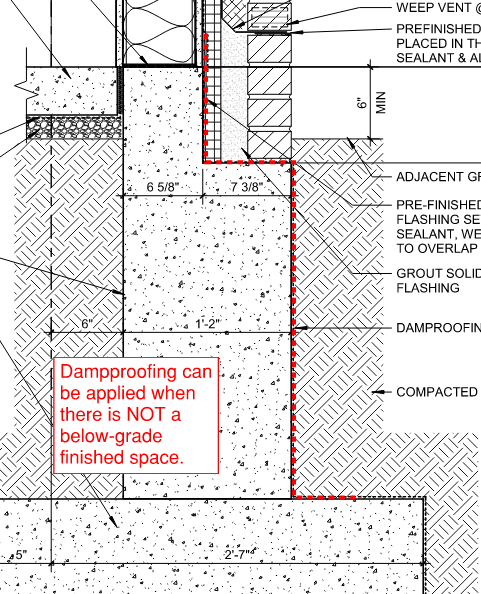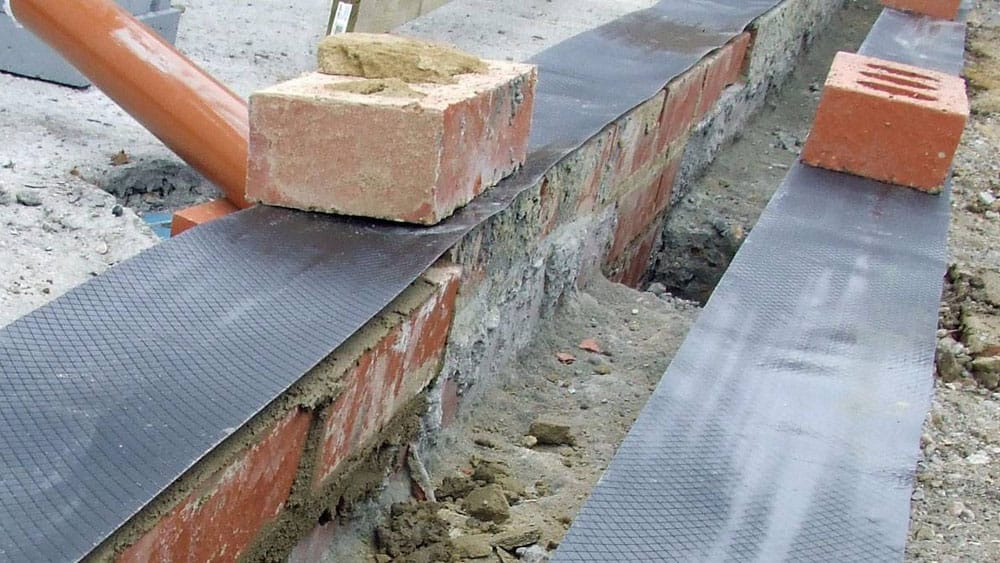Exploring the Various Methods and Solutions for Effective Damp Proofing
Dampness in structures poses substantial obstacles to both architectural stability and interior air top quality. Numerous strategies and remedies have emerged to battle this prevalent concern. From typical damp-proof membranes to ingenious chemical treatments, each technique uses special advantages. Understanding these alternatives is crucial for reliable dampness control. Nonetheless, selecting the appropriate remedy relies on specific structure conditions and requirements, prompting further exploration into the most reliable moist proofing methods offered.
Recognizing the Sources Of Dampness
Although wetness can arise from various sources, recognizing these causes is vital for effective remediation. Commonly, moisture stems from three primary resources: increasing wet, passing through damp, and condensation. Climbing damp happens when groundwater travels up-wards with permeable products, such as block or stone, frequently due to an absence of an efficient barrier (damp proofing newcastle). Passing through damp is generally brought on by exterior factors, including roof leakages, damaged seamless gutters, or harmed walls, enabling water to infiltrate a residential property. Condensation, on the various other hand, arises from excess dampness airborne, commonly aggravated by poor ventilation and temperature level distinctions, bring about water droplets basing on surface areas. Identifying these underlying concerns is important, as each sort of dampness needs a customized strategy for remediation. Appropriate evaluation assists in figuring out one of the most efficient remedies, ultimately safeguarding the architectural honesty of a structure and boosting interior air top quality
Traditional Damp-Proof Membranes

Chemical Damp-Proofing Solutions
Chemical damp-proofing remedies offer a cutting-edge technique to stop wetness breach in buildings. These approaches normally entail the application of fluid chemicals that penetrate masonry and create a barrier against increasing damp. Commonly used chemicals consist of silanes, siloxanes, and various other water-repellent agents that respond with surface area products to develop a hydrophobic layer.The application process usually needs exploration openings right into the wall surfaces, injecting the chemical service, and enabling it to heal. This technique is particularly advantageous for older structures where conventional damp-proof membranes might be not practical. Chemical damp-proofing can be less disruptive and more economical than substantial restoration projects.While efficient, these solutions depend on proper application and ecological conditions for peak performance. damp specialist newcastle. Routine maintenance and surveillance are necessary to assure the longevity of the damp-proofing treatment. On the whole, chemical damp-proofing represents a functional choice for protecting buildings versus moisture-related damage
Tooth Cavity Wall Surface Building Techniques
Dental caries wall surface construction methods provide countless advantages, especially in wetness control and power performance. By integrating an air space in between two layers of masonry, these wall surfaces effectively reduce water ingress while improving insulation. This mix not only protects frameworks from wetness yet additionally contributes to decreased power consumption.
Benefits of Dental Caries Walls
When considering effective damp proofing approaches, the advantages of tooth cavity walls stand apart plainly. Dental caries wall surfaces contain 2 separate layers, creating an air space that successfully reduces wetness penetration. This layout lessens the danger of wetness, as the external wall surface works as an obstacle versus rain and water access. Furthermore, dental caries walls enhance thermal insulation, which contributes to energy efficiency by minimizing warm loss. They additionally offer audio insulation, helping to develop a quieter interior setting. Furthermore, the air space allows for air flow, which aids in dampness control and reduces the probability of mold and mildew development. These advantages not just improve the total convenience of a structure however additionally add to its durability and structural honesty.
Moisture Control Methods
Efficient wetness control techniques are important in tooth cavity wall building and construction to ensure lasting protection against moisture. One primary method involves the incorporation of weep openings, which help with water drain from the dental caries, preventing buildup. Furthermore, using breathable membrane layers can help manage moisture levels while permitting trapped vapor to get away. Correct positioning of insulation is additionally essential, as it needs to not block water drainage paths. Ensuring that the external leaves of the tooth cavity wall are built with water-resistant materials boosts general toughness. Regular upkeep checks are important to determine any kind of blockages or damages early, protecting the structure's honesty. Inevitably, a combination of these methods creates a durable defense against dampness intrusion in cavity walls.
Insulation and Power Efficiency
Insulation plays a crucial duty in enhancing power performance within dental caries wall building. By incorporating shielding products, these wall surfaces develop a thermal obstacle that lessens warm loss and minimizes energy consumption. Reliable insulation not only assists preserve a steady indoor temperature level however likewise alleviates the danger of moisture, as it protects against condensation within the wall surface cavity. Various methods, such as the usage of rigid foam boards or mineral wool, can be utilized to attain excellent insulation efficiency. Additionally, appropriate setup is necessary to guarantee that spaces and gaps are lessened, which can or website else compromise energy performance. Ultimately, a well-insulated cavity wall contributes considerably to general sustainability and decreases home heating and cooling prices for property owners.
Outside Damp Proofing Methods
Outside wet proofing techniques are crucial for shielding frameworks from dampness seepage. Two effective methods consist of the application of water-proof membranes and the installment of French drains. These options aid alleviate water build-up and maintain the stability of buildings.
Waterproof Membrane Layer Application
While different approaches exist for avoiding moisture access, the application of water resistant membranes remains an extremely efficient external damp proofing method. These membranes are generally made from materials such as polyethylene, rubber, or modified asphalt, supplying a durable barrier versus water infiltration. The setup procedure entails using the membrane layer to the exterior surfaces of wall surfaces or structures, guaranteeing total insurance coverage to stop leakages. Proper attachment and securing at joints are essential to maximizing performance. Waterproof membranes can be used in numerous forms, consisting of fluid coatings and sheet membranes, permitting versatility based on the details demands of the structure. This technique not just shields structures from moisture but also enhances their long life and structural integrity.
French Drainpipe Installment
One effective technique for taking care of groundwater and stopping dampness build-up around a structure's structure is the installation of a French drain. This drain system includes a trench loaded with gravel and a perforated pipe that reroutes surface area water far from the foundation. Correct setup requires careful preparation, guaranteeing that the drain inclines far from the framework to facilitate excellent water circulation. Furthermore, the area of the drainpipe is crucial; it must be positioned in locations susceptible to merging or excess wetness. Regular maintenance, consisting of clearing up particles from the crushed rock and making sure the pipe continues to be unhampered, is vital for long-term efficiency. Eventually, a well-installed French drainpipe can considerably lower the risk of water-related concerns in basements and foundations.
Inside Waterproofing Methods
Interior waterproofing techniques are vital for safeguarding a structure's inside from wetness seepage and possible water damages. These techniques commonly involve the application of specialized products and methods made to develop a moisture obstacle within the structure. One usual method is making use of water resistant coverings or sealants on walls and floorings, which stop moisture from passing through surfaces.Additionally, setting up indoor drain systems, such as sump pumps, can properly manage water build-up in basements and creep areas. Another method includes making use of vapor obstacles, which are mounted to hinder wetness motion from the ground into living spaces.Moreover, resolving any type of cracks or voids in wall surfaces or foundations with proper sealants assures a thorough defense versus water breach. By implementing these interior waterproofing approaches, homeowner can significantly decrease the danger of mold and mildew growth, architectural damage, and other moisture-related issues. Correct execution of these strategies is crucial for long-term security and building stability.
Normal Upkeep and Evaluation Practices
Regular maintenance and inspection techniques are important for ensuring the long-term efficiency of damp proofing solutions in any type of structure. Regular checks enable homeowner to identify very early signs of dampness breach, such as peeling paint, mold and mildew growth, and stuffy smells. These indications can indicate underlying issues that require prompt attention.Inspections must be performed at the very least each year, focusing on vulnerable locations like cellars, creep rooms, and exterior wall surfaces. Throughout these assessments, homeowner must take a look at sealants, drainage systems, and ventilation to validate they operate correctly.Additionally, maintaining downspouts and seamless gutters is crucial, as clogged up systems can bring about water accumulation near the structure. Carrying out a routine upkeep timetable, in addition to prompt repairs, can substantially expand the lifespan of moist proofing procedures and protect the architectural honesty of the structure. Proactive measures eventually add to the general health and wellness of the living setting.
Often Asked Questions
The Length Of Time Does Damp Proofing Commonly Last?
The duration of wet proofing performance differs, normally lasting between 20 to 50 years. Variables such as application quality, ecological problems, and upkeep techniques significantly influence the long life of the wet proofing therapy.

Can I Damp Proof My Home Myself?
The private pondered the expediency of DIY damp proofing. With proper study and the appropriate products, it is feasible. However, they also acknowledged the importance of specialist assistance to assure resilient effectiveness and protect against future problems.
What Are the Indications of Inefficient Damp Proofing?
Signs of inadequate damp proofing consist of persistent musty odors, noticeable mold and mildew development, peeling off paint, wet spots on walls, and timber degeneration - damp specialist newcastle. Home owners ought to deal with these concerns quickly to protect against further damages and health concerns
Does Damp Proofing Affect Indoor Air Quality?

Just How Much Does Specialist Damp Proofing Expense?
Specialist wet proofing costs vary substantially, normally ranging from $1,000 to $5,000 depending on the property's size, the extent of the damp issue, and chosen methods. Each circumstance calls for a customized analysis for exact prices. Generally, dampness stems from three key sources: climbing wet, passing through wet, and condensation. When thinking about effective damp proofing approaches, the benefits of cavity walls stand out prominently. External wet proofing methods are crucial for protecting frameworks from wetness seepage. While various methods exist for stopping moisture access, the application of water-proof membrane layers remains a very efficient exterior damp proofing strategy. Signs of inefficient wet proofing consist of persistent musty odors, noticeable mold development, peeling paint, damp spots on walls, and wood degeneration.